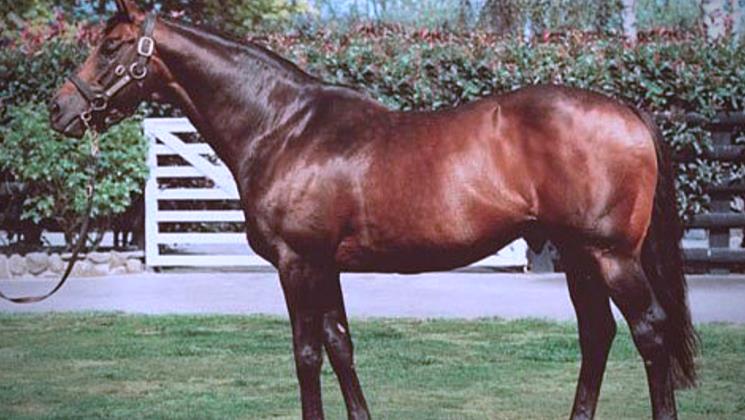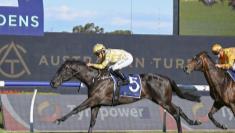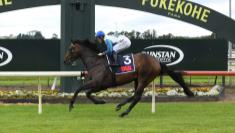
A-Z of New Zealand greats - Zabeel
Few thoroughbreds in modern times have had a more significant impact on the New Zealand racing industry than Zabeel.
He was first in the limelight as a yearling and was rarely out of the headlines over the following 25 years.
He was described as “poetry in motion” on the racetrack but his race career was just the entrée to the main course.
By the time Zabeel was retired from stud duties, in 2013, at the age of 27, he had proved that lightning can strike twice for Patrick Hogan and Cambridge Stud.
Hogan had never imagined that he would have another stallion to compare with Sir Tristram, but he found one in a son of Sir Tristram.
Zabeel had a staggering stud career. He has sired 46 individual Group I – one more than Sir Tristram and a NZ record – and is the damsire of 40 individual Group I winners and counting.
He won the Dewar Stallion Trophy, for the NZ sire with the highest combined Australian and NZ earnings in a season, 15 times, including 13 years in succession.
He was the leading NZ sire four times and twice won the Australian premiership, the latter being no mean feat in the era of Danehill.
Zabeel has also been the leading Australian broodmare sire three times and earned the equivalent NZ title five times.
Champion sires – and Zabeel certainly comes into that category – are rare and virtually priceless. They significantly lift the profile and profitability of their studs and can return tens of millions of dollars in revenue.
The rewards come from all quarters, including stud fees, yearling sales, shareholder dividends and the residual value of their fillies. There is nothing else like it in racing.
Zabeel, who was by Sir Tristram from a Nureyev mare, had all the attributes of a successful stallion. In addition to an attractive pedigree, he was a lovely individual and measured up to the best of his generation on the track.
Leading Australian horseman Colin Hayes rated Zabeel as the best colt at the 1988 national yearling sale, the first to be held at the Karaka complex, and stable client Sheikh Hamdan went to $650,000 – the third highest price of the sale -to buy the horse.
Zabeel, who was bred by Robert Sangster, was born at Cambridge Stud but soon after the dam, Lady Giselle, and her foal became part of a partnership put together by Arrowfield Stud and Zabeel went through the sale ring as part of the Ra Ora Stud draft.
It was Hayes who described Zabeel as poetry in motion, after the colt had won the Group I Australian Guineas at Flemington by three lengths.
Zabeel won seven of his 19 starts and earned more than $1 million in stakes. He won a Group I and two Group II races in Australia at three, in a strong crop, and was also a Group II winner and Group I-placed from five starts at four.
Yet Hogan was able to buy Zabeel, after the horse had finished racing, for not a lot more than he had cost as a yearling.
Both Hayes and Hogan were among those invited to make an offer for Zabeel when he finished racing. When the envelopes were opened, Hogan had offered $750,000 and Hayes $700,000.
Hayes is believed to have been given the chance to match Hogan’s offer but was also committed to further investment in his Lindsay Park property and was unwilling to extend his offer, at a time when the bloodstock market was at a low ebb.
Though Hayes no doubt regretted that decision later, he and Hogan were operating in a very different market in 1991 from the one that existed when Zabeel made $650,000 as a yearling.
The average price for the premier session in the inaugural sale at Karaka was $112,801, with a median of $75,000.
By 1991, when Hogan had his chance to buy Zabeel, the premier session average had plunged to $41,530, with a median of $26,000. It was no better the following year and it was to be 2000 before the premier session average returned to six figures, a level that was reached three times in the late 1980s.
Zabeel stood at $10,000 for his first three seasons but it did not take long for his stock to make an impact on the track.
His first crop son Octagonal was a dual Group I winner at two and runner-up in the Golden Slipper and finished with 10 Group I wins.
Melbourne Cup winner Jezabeel and Adelaide Cup winner Cronus also emerged from Zabeel’s first crop and his second crop stars included Might And Power and Mouawad.
Zabeel left four Cox Plate winners - Octagonal, Might And Power, Savabeel and Maldivian – and the Melbourne Cup winners Might And Power, Jezabeel and Efficient.
His Derby winners include Octagonal. Zonda, Sky Heights, Efficient, St Reims, Fiumicino, Don Eduardo and Greys Inn.
Zabeel has also succeeded as a sire of sires, most notably with Savabeel, who has been both the leading NZ sire and the Dewar Trophy winner in each of the past six seasons. Reset and Octagonal were also successful sires and Don Eduardo, Zed, Colombia, and Greys Inn have all left Group I winners.
Zabeel mares will continue to be a force for many years and have already produced a host of top-class gallopers, including Dundeel, Ocean Park, Darci Brahma, Silent Achiever, Atlantic Jewel, Bonneval, Werther, Samantha Miss and Humidor.
Zabeel died in 2017, aged 29, and is buried at Cambridge Stud, next to Sir Tristram.









